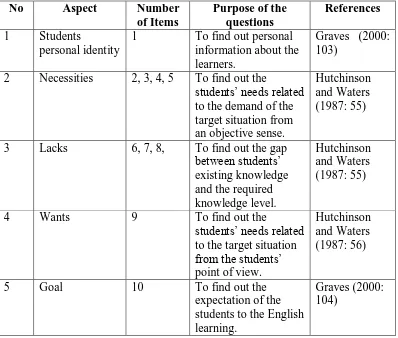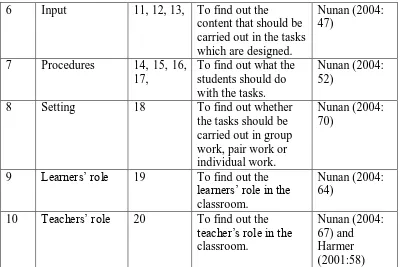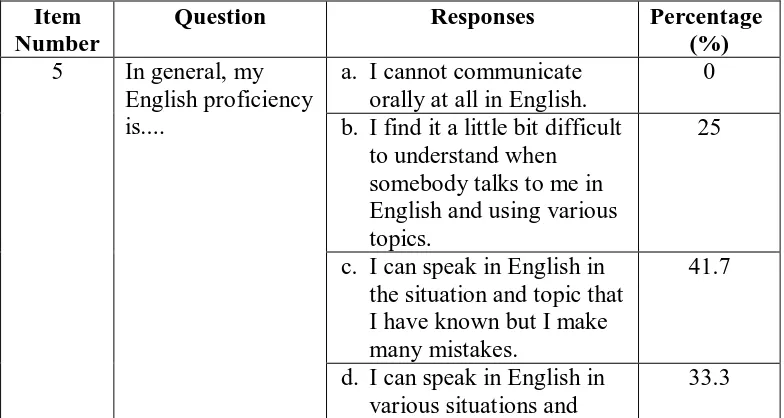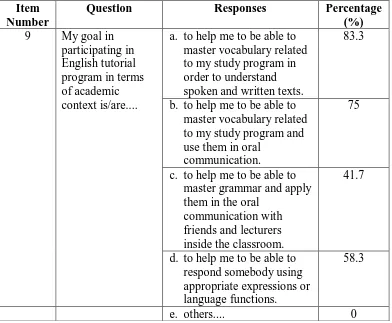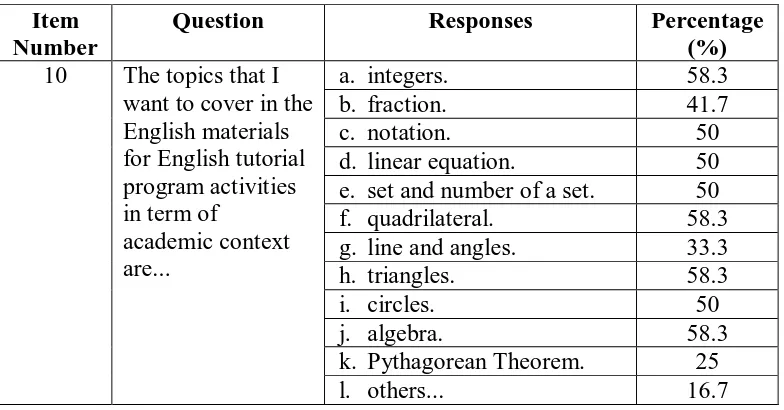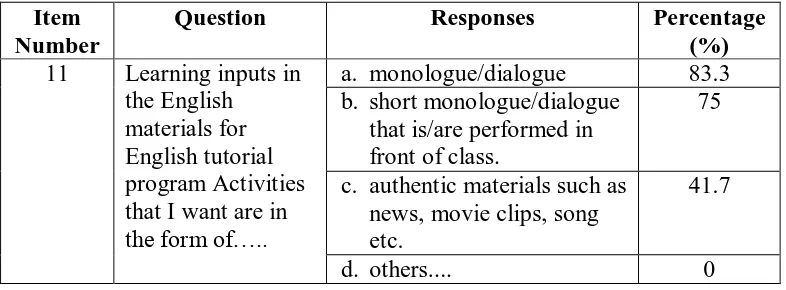Informasi Dokumen
- Penulis:
- Titi Nawangsari
- Pengajar:
- Bapak Jaka Priyana, Ph.D
- Ibu Siti Sudartini, M.A
- Ibu Ella Wulandari, M.A
- Sekolah: Yogyakarta State University
- Mata Pelajaran: English Language Education
- Topik: Developing Appropriate English Speaking Learning Materials for English Tutorial Program for the Students of International Mathematics Education Study Program of Yogyakarta State University
- Tipe: thesis
- Tahun: 2014
- Kota: Yogyakarta
Ringkasan Dokumen
I. INTRODUCTION
This section introduces the research topic, focusing on the development of English speaking learning materials for students in the International Mathematics Education Study Program at Yogyakarta State University. The background highlights the need for effective English communication skills among students in international programs, emphasizing the challenges they face due to language barriers. The research aims to provide tailored materials that enhance students' speaking abilities, aligning with their academic and daily life contexts.
1.1 Background of the Study
The background discusses Yogyakarta State University's vision of becoming a world-class institution and the role of English proficiency in achieving this goal. It outlines the increasing demand for English skills among students in international programs and the necessity for specialized materials that cater to their specific needs in both academic and everyday situations.
1.2 Identification of the Problems
This subsection identifies the primary challenges faced by students in the English tutorial program, including the inadequacy of existing materials. It emphasizes the need for coursebooks and supplementary resources that are scientifically developed and aligned with the students' proficiency levels and specific content areas relevant to their studies.
1.3 Limitation of the Problems
The research focuses specifically on developing materials for intermediate-level students in the International Mathematics Education Study Program, particularly in the context of academic English. This limitation allows for a targeted approach to address the specific language needs of these students.
1.4 Formulation of the Problems
The problems are formulated to explore the target and learning needs of the students, as well as to identify the appropriate materials required for enhancing their speaking skills. This structured approach guides the research methodology and material development process.
1.5 Objectives of the Study
The objectives outline the aims of the study, which include identifying students' target and learning needs and developing suitable English speaking materials. This clear articulation of goals provides a framework for evaluating the success of the research.
1.6 Significance of the Study
The significance section highlights the potential contributions of the research to various stakeholders, including English instructors, materials designers, and the students themselves. It emphasizes the importance of tailored materials in facilitating effective language learning and improving communication skills.
II. LITERATURE REVIEW AND CONCEPTUAL FRAMEWORK
This chapter reviews relevant literature that informs the development of the English speaking materials. It discusses key theories related to speaking, English for Specific Purposes (ESP), and Content-Based Instruction (CBI), providing a theoretical foundation for the research. The conceptual framework is established to guide the material development process, ensuring that it aligns with the identified needs of the students.
2.1 Theories of Speaking
This section explores various theories related to speaking, including the nature of speaking, micro and macro skills, and types of speaking performance. It emphasizes the importance of fluency and accuracy in communication, providing insights into the skills that need to be developed through the tutorial program.
2.2 English for Specific Purposes
This subsection defines ESP as an approach that tailors language instruction to meet the specific needs of learners. It discusses the importance of conducting needs analysis to determine target and learning needs, which is crucial for developing effective learning materials.
2.3 Content-Based Instructions
CBI is discussed as a method that integrates content learning with language acquisition. The principles of CBI, such as relevance to students' lives and the use of authentic materials, are outlined, highlighting their significance in designing engaging and effective learning experiences.
2.4 Learning Materials Development
This subsection focuses on the criteria for developing good learning materials, emphasizing the need for alignment with students' proficiency levels and contextual relevance. It discusses the process of materials development, including the selection of appropriate content and tasks that facilitate language learning.
2.5 Unit Design Development
The principles of unit design are explored, including task grading and sequencing. This section highlights the importance of structured units that guide students through progressively challenging tasks, ensuring a coherent learning experience.
2.6 Task Design Development
Task design is examined in terms of its definition, components, and types. This section emphasizes the need for varied task types that engage students and promote active learning, which is essential for developing speaking skills.
2.7 Materials Evaluation
The evaluation of materials is discussed, focusing on the criteria that determine their appropriateness for the intended audience. This section underscores the importance of feedback from experts and users in refining the developed materials.
2.8 Conceptual Framework
The conceptual framework synthesizes the theories and principles discussed in the literature review, providing a visual representation of how these elements interconnect to inform the material development process. It serves as a guide for ensuring that the developed materials effectively meet the identified needs of the students.
III. RESEARCH METHOD
This chapter outlines the research design and methodology employed in the study. It details the procedures followed for data collection, analysis, and the development of the learning materials. The research setting and subjects are described, providing context for the study.
3.1 Research Design
The research design is based on a Research and Development (R&D) approach, which involves systematic procedures for developing and evaluating educational materials. This section outlines the steps taken to ensure that the research aligns with established methodologies.
3.2 Research Setting
The research setting is described, focusing on the context of Yogyakarta State University and the specific characteristics of the International Mathematics Education Study Program. This provides insight into the environment in which the study was conducted.
3.3 Research Subjects
This subsection identifies the participants involved in the study, including the students from the International Mathematics Education Study Program. It discusses their demographics and relevant characteristics that inform the material development process.
3.4 Research Procedure
The research procedure outlines the systematic steps taken to collect data, develop materials, and evaluate their effectiveness. This section emphasizes the importance of a structured approach in achieving the research objectives.
3.5 Data Collection Techniques and Instruments
This subsection describes the data collection methods used in the study, including questionnaires and interviews. It discusses how these instruments were designed to gather relevant information about students' needs and preferences.
3.6 Data Analysis Technique
The data analysis techniques employed in the study are outlined, focusing on the methods used to interpret the collected data. This section highlights the importance of thorough analysis in informing the material development process.
IV. RESEARCH FINDINGS AND DISCUSSION
This chapter presents the findings of the research, detailing the needs analysis results, course grid development, and the evaluation of the materials. It discusses the implications of these findings for the development of effective English speaking materials.
4.1 Research Findings
The research findings section summarizes the key results from the needs analysis, highlighting the target and learning needs of the students. It provides insights into the specific areas where students require support in developing their speaking skills.
4.2 The Course Grid
This subsection outlines the course grid developed based on the needs analysis results. It details the structure of the materials, including the topics covered and the progression of tasks designed to enhance students' speaking abilities.
4.3 The Unit Design
The unit design section describes the organization of the developed materials into coherent units. It emphasizes the importance of a structured approach in facilitating effective learning experiences for students.
4.4 The First Draft of the Materials
This subsection presents the initial draft of the learning materials developed for the English tutorial program. It discusses the content and structure of the materials, highlighting their alignment with the identified needs of the students.
4.5 The Expert Judgment
The expert judgment section discusses the feedback received from materials experts regarding the developed materials. It emphasizes the importance of expert evaluation in ensuring the quality and appropriateness of the materials.
4.6 The Final Draft of the Materials
This subsection presents the final draft of the learning materials, incorporating revisions based on expert feedback. It discusses the improvements made to enhance the effectiveness of the materials in supporting students' speaking skills.
4.7 Discussions
The discussion section reflects on the findings of the research, exploring their implications for the development of English speaking materials. It emphasizes the importance of tailoring materials to meet the specific needs of students in international programs.
V. CONCLUSIONS AND SUGGESTIONS
This chapter summarizes the key findings of the research and provides conclusions based on the analysis. It offers suggestions for future research and practical applications of the developed materials in the English tutorial program.
5.1 Conclusions
The conclusions section summarizes the main findings of the research, emphasizing the effectiveness of the developed materials in addressing the speaking needs of students in the International Mathematics Education Study Program. It highlights the importance of needs analysis in guiding material development.
5.2 Suggestions
This subsection offers practical suggestions for implementing the developed materials in the English tutorial program. It discusses potential areas for further research and the importance of continuous evaluation and improvement of language learning resources.
VI.REFERENCES
This section lists the references cited throughout the thesis, providing a comprehensive bibliography of the sources used in the research.
VII.APPENDICES
The appendices include supplementary materials such as questionnaires, data analysis results, and additional resources that support the research findings. These materials provide further context and evidence for the study.
Referensi Dokumen
- Longman English Grammar Practice for Intermediate Students ( Alexander, L.G. )
- Function in English ( Blundell, Jon., Higgens, Jonathan & Middlemiss, Nigel )
- Module of Introduction of Business English ( Suciati )
- Presenting in English ( Powell, Mark )
- Grammar Practice for Upper Intermediate Students ( Walker, Elaine & Elsworth, Steve )

